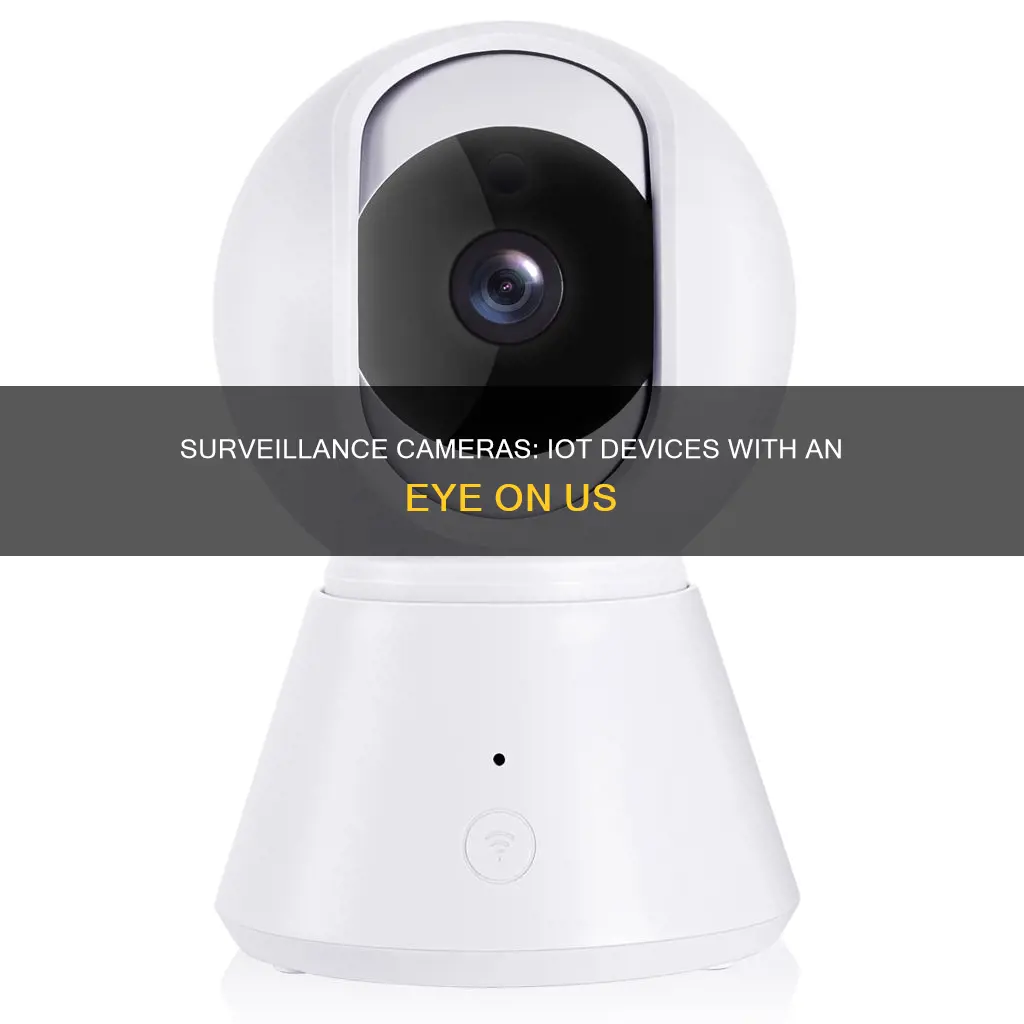
The Internet of Things (IoT) has transformed the capabilities of surveillance cameras. In the past, surveillance cameras, such as closed-circuit television (CCTV) systems, were limited to recording footage for later review. Now, with IoT connectivity, surveillance cameras can do much more. IoT-enabled cameras can provide real-time streaming that can be remotely viewed from anywhere, and they can also communicate with other devices to set off alarms or alert security personnel. These smart cameras offer enhanced functionality, improved performance, and expanded capabilities, making them a popular choice for security and monitoring in various sectors, including businesses, industries, and governments.
| Characteristics | Values |
|---|---|
| Purpose | Security and monitoring |
| Functionality | Real-time footage, remote access, two-way communication, facial recognition, smoke detection, fire detection, intruder detection, traffic monitoring, shoplifting detection, incident detection, data gathering |
| Benefits | Improved security, better monitoring, faster response times, improved customer service, greater efficiency, enhanced functionality, improved performance, advanced analytics, ease of use |
| Risks | Cyberattacks, data breaches, privacy invasion, hardware attacks, DDoS attacks, malware, hacking, lack of supervision, high performance, high bandwidth, default passwords, insufficient security measures |
What You'll Learn
- IoT surveillance cameras can be used to monitor foot traffic in retail stores and public spaces
- They can be used to track suspected shoplifters and alert security
- They can be used to monitor entry points for potential intruders
- They can be used to detect and interpret incidents autonomously
- They can be used to monitor dangerous areas and restrict access

IoT surveillance cameras can be used to monitor foot traffic in retail stores and public spaces
The Internet of Things (IoT) has had a significant impact on video surveillance, with IoT security solutions now being used to monitor and secure facilities more effectively. IoT surveillance cameras are a popular application in the IoT and security solution sector, with their ability to connect to other devices and perform a range of tasks beyond just recording video.
One of the main uses of IoT surveillance cameras is to assess foot traffic in retail stores and public spaces. By leveraging IoT technology, retailers can gain valuable insights into customer behaviour and make data-driven decisions to optimise their operations. For example, by monitoring foot traffic, retailers can identify high-traffic areas in their stores and adjust product placements or promotions accordingly. Additionally, IoT cameras can be used to count the number of people entering and exiting a store, providing valuable data for understanding customer conversion rates and staffing requirements.
In public spaces, IoT surveillance cameras can be used to monitor and manage crowds, ensuring the safety and security of large gatherings. This technology can also be applied to monitor traffic in cities, helping to optimise traffic flow and reduce congestion.
The benefits of using IoT surveillance cameras for foot traffic monitoring include real-time data and analytics, remote access, and the ability to integrate with other sensors and systems. For example, in the case of a fire, IoT cameras can detect smoke and trigger notifications to the appropriate authorities, helping to minimise damage and ensure public safety.
While IoT surveillance cameras offer enhanced capabilities, there are also security concerns that need to be addressed. IoT devices, including cameras, have been targeted by hackers due to their constant connectivity and high computing power. To mitigate these risks, it is important for manufacturers, service providers, and users to implement robust security measures, such as enforcing the changing of default credentials and using secure connections.
Leasing Infrared Cameras: Understanding Finance Charges
You may want to see also

They can be used to track suspected shoplifters and alert security
Surveillance cameras are a key component of the Internet of Things (IoT) and are often utilized in retail settings to enhance security and protect assets. In the context of shoplifting, these cameras can play a crucial role in deterring, detecting, and preventing such incidents. Modern surveillance cameras, as part of an IoT ecosystem, offer advanced features that can assist in tracking suspected shoplifters and alerting security personnel in real time.
One of the primary ways IoT-enabled cameras aid in shoplifter tracking is through facial recognition technology. These cameras can be programmed to detect and recognize faces, matching them against a database of known shoplifters or suspicious individuals. When a suspected shoplifter enters the store, the camera can identify them and immediately alert security staff, allowing for discreet and proactive monitoring. This early warning system enables security personnel to keep a close eye on the individual, potentially preventing a shoplifting incident before it occurs.
Beyond facial recognition, surveillance cameras with IoT capabilities can also track suspected shoplifters through advanced motion detection and behavior analysis. These cameras can identify unusual or suspicious movements, such as loitering in specific areas or displaying nervous mannerisms. By leveraging computer vision and machine learning algorithms, the cameras can analyze an individual's body language and movements, triggering alerts if suspicious behavior is detected. This helps security staff identify potential shoplifters who may not be in their database but are exhibiting suspicious patterns.
In addition to tracking, IoT-enabled cameras can also facilitate immediate response and intervention. Once a suspected shoplifter is identified, the system can automatically alert security personnel through notifications sent to their mobile devices or control rooms. This ensures a swift and targeted response, allowing staff to intercept the individual and prevent any potential loss. The cameras can also be integrated with access control systems, triggering actions such as locking emergency exits or activating additional lighting to deter the suspected shoplifter and increase the chances of apprehension.
Focusing Your iPhone 6 Camera: Tips and Tricks
You may want to see also

They can be used to monitor entry points for potential intruders
Surveillance cameras are now part of the Internet of Things (IoT), which connects devices for greater efficiency. IoT security cameras can be used to monitor entry points for potential intruders in several ways.
Firstly, they can be placed at entry points such as front and back doors, gates, fences, windows, driveways, and garages to detect intruders and monitor their activity. This allows for a clear view of anyone entering or exiting the property. It is important to position the cameras at an angle that covers the entire entry point and ensures that all crucial details are captured.
Additionally, IoT security cameras can be equipped with advanced features such as facial recognition and computer vision, enabling them to identify intruders or suspicious individuals. These cameras can also be connected to other devices and set off alarms or alert security personnel when potential threats are detected.
Moreover, IoT cameras can be used in conjunction with motion-activated floodlights or spotlights to deter intruders and improve visibility during nighttime or low-light conditions. By strategically placing cameras and utilizing their advanced capabilities, property owners can enhance the security of their homes or businesses, providing peace of mind and protection against potential intruders.
Traffic School: Camera Tickets, What You Need to Know
You may want to see also

They can be used to detect and interpret incidents autonomously
Surveillance cameras are a part of the Internet of Things (IoT) network, which connects devices for greater efficiency. The IoT network allows surveillance cameras to do much more than just record video footage.
One of the key benefits of IoT surveillance cameras is their ability to detect and interpret incidents autonomously. This means that these cameras can identify and analyse incidents without the need for human intervention. For example, an IoT camera with facial recognition technology can identify an intruder or an unauthorised person in a restricted area and automatically alert security personnel or take other appropriate actions, such as locking down the area.
The autonomous detection and interpretation capabilities of IoT surveillance cameras are enhanced by advanced technologies such as computer vision and artificial intelligence (AI). Computer vision enables cameras to derive meaningful information from images and videos, such as identifying suspicious activities or objects. AI, on the other hand, enables cameras to make intelligent decisions and take appropriate actions based on the analysed data.
The combination of these technologies allows IoT surveillance cameras to monitor and interpret incidents in real time, providing valuable support to security personnel and law enforcement agencies. For instance, in the case of a fire, an IoT camera with computer vision can detect smoke before a smoke detector goes off and automatically alert the fire department, improving emergency response times.
In addition to detecting and interpreting incidents, IoT surveillance cameras can also track objects and individuals. For example, license plate recognition technology enables cameras to identify and track vehicles, which is useful for monitoring traffic violations, locating stolen cars, or investigating hit-and-run accidents. Similarly, facial recognition technology can be used to track and identify individuals, which is valuable for finding missing persons or identifying suspects in a crowd.
The ability of IoT surveillance cameras to autonomously detect, interpret, and respond to incidents enhances security and public safety. By providing timely notifications and alerts, these cameras enable a faster response to emergencies and improve the efficiency of security personnel and law enforcement agencies.
Understanding Camera Drive Modes: Unleashing Your Photography Skills
You may want to see also

They can be used to monitor dangerous areas and restrict access
Surveillance cameras are increasingly being used in conjunction with the Internet of Things (IoT) to monitor dangerous areas and restrict access. The IoT allows surveillance cameras to be connected to other devices and sensors, enabling them to do much more than simply record footage.
For example, IoT security cameras can be used to monitor areas prone to flooding and alert officials once a certain threshold is met. This allows for quick action, such as communicating the danger to residents and arranging evacuations. Similarly, security cameras have been used to monitor and detect wildfires, providing valuable information to emergency services and allowing them to make critical decisions.
In addition to monitoring natural disasters, IoT security cameras can also help to secure buildings and facilities. They can be used to detect and interpret incidents, track suspected intruders, and alert security personnel or authorities in the event of a break-in. For instance, if an IoT camera detects an unauthorized person in a restricted area, it can automatically lock down the area or notify security guards.
Furthermore, IoT surveillance cameras can be used to monitor and control access to specific areas. Facial recognition technology can be used to identify individuals and restrict access to authorized personnel only. This can be particularly useful in high-security areas or sensitive locations.
The ability to monitor and restrict access to dangerous areas is a significant advantage of IoT-enabled surveillance cameras. By combining real-time footage with data from sensors and other devices, these systems can enhance safety, security, and emergency response capabilities.
Understanding Camera Raw Measurements: Unlocking Photography's Power
You may want to see also
Frequently asked questions
IoT surveillance cameras offer a range of benefits over traditional CCTV cameras. They can provide real-time streaming that can be viewed remotely from anywhere, and they can communicate with other devices to set off alarms or alert security personnel to potential threats. They also offer advanced features such as facial recognition and computer vision, which can identify intruders or suspicious individuals.
IoT surveillance cameras are connected devices, which means they expand the attack surface and make it easier for cyberattacks to take place. They often have simple default passwords that users do not change, making them vulnerable to hacking. Being IoT devices, they also have access to vast amounts of data, which makes them appealing targets for attackers.
IoT surveillance cameras have a wide range of applications in business, industry and society. They can be used in smart cities to monitor vehicle and foot traffic, addressing congestion problems. They can also be used in retail establishments to understand customer traffic patterns and identify shoplifting. In addition, they can be used for building security, remote monitoring of homes and offices, and assessing foot traffic in commercial buildings.







